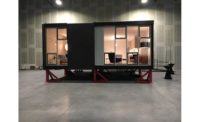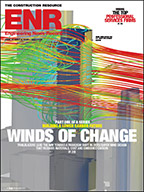Keith Bentley, one of the founders of Bentley Software, summed up the state of design software's evolution from CAD to CADD and now BIM—and a lot more about the state of the industry—when he observed: Software for design and construction is facing a significant change order to keep pace with the evolution of the internet, cloud and powerful new hardware and form factors.
"Everything about the workflows has to anticipate being connected," he said during a keynote address at the software firm's annual "Year in Infrastructure" event, held in London in early November.
"I think we need a new and expanded data model," Bentley noted about how BIM tools are deployed. "Basically, the data types that we store internally are centered around their physical properties. We need to invert that so they are centered on business properties. The physical and geometric properties are then related to that."
The CTO, who doesn't make as many public appearances as his brother and CEO, Greg, talked about the breadth of change washing over the industry's traditional tools for design, and what this means for the trade-offs that developers make when building software for design engineering. "If you look back five years ago, I don't think most of what we're talking about here today [cloud computing, interoperability, core data models and shared across different vendors' platforms] would have been possible." That's why he's calling this current wave of innovation a big one, similar to the advent of the web some 20 years ago.
His remarks came as Bentley announced a major upgrade to all of its software product lines, including its MicroStation design platform and ProjectWise collaboration tools. Called the "Connect" editions, the upgrade extends integration and interopability among the different software groups in Bentley's portfolio. The upgrade is also a reflection of how quickly software design is advancing to leverage internet-based technologies, but also has to work with hybrid environments such as traditional desktops.
The new versions function as an integrated mix of software, services and managed hosting that work with Microsoft's Azure cloud services. Huw Roberts, vice president of platforms for Bentley also added: The connected concept in a common environment is what makes this all possible. The other aspect is extending capabilities – cloud, optioneering, dashboards – they're not new. But extending those capabilities is another key aspect of the connect edition, he said.
Take the MicroStation update and functional components with catalog services. Roberts said Bentley has a long history of very strong parametric systems, like generative components, within its key products. "This unifies those parametric experiences so they can all work together. [Users] can work through those catalog services into [their] dashboards. And into all the different modeling enviornments that you're dealing with," he continued.
But deploying software across different environments—desktop, cloud, on a mobile device—is also a big job for makers of the sophisticated tools that Bentley offers and one that always involves trade-offs with programmers and software developers.
Added Keith Bentley: "My promise to you is that, when we give you a demonstration of something that runs on the cloud, on a browser and on a desktop computer, it will look the same using any form factor that you want [running on] Android, Windows or iOS operating systems," he said. "That's a big job for us. It's a big problem [in the industry] but that is our mission."



Post a comment to this article
Report Abusive Comment